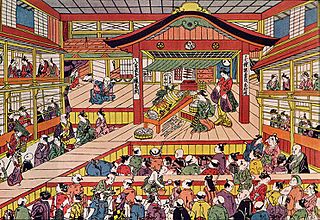
Ukiyo-e (浮世絵) is a genre of Japanese art that flourished from the 17th through 19th centuries. Its artists produced woodblock prints and paintings of such subjects as female beauties; kabuki actors and sumo wrestlers; scenes from history and folk tales; travel scenes and landscapes; flora and fauna; and erotica. The term ukiyo-e translates as 'picture[s] of the floating world'.

Kawai Gyokudō was the pseudonym of a Japanese painter in the nihonga school, active from Meiji through Shōwa period Japan. His real name was Kawai Yoshisaburō.

Hasui Kawase was a Japanese artist who was one of 20th century Japan's most important and prolific printmakers. He was a prominent designer of the shin-hanga movement, whose artists depicted traditional subjects with a style influenced by yōga. Like many earlier ukiyo-e prints, Hasui's works were commonly landscapes, but displayed atmospheric effects and natural lighting.
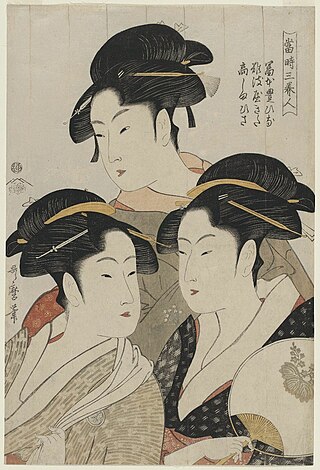
Bijin-ga is a generic term for pictures of beautiful women in Japanese art, especially in woodblock printing of the ukiyo-e genre.

Shinsui Itō was the pseudonym of a Nihonga painter and ukiyo-e woodblock print artist in Taishō- and Shōwa-period Japan. He was one of the great names of the shin-hanga art movement, which revitalized the traditional art after it began to decline with the advent of photography in the early 20th century. His real name was Itō Hajime.
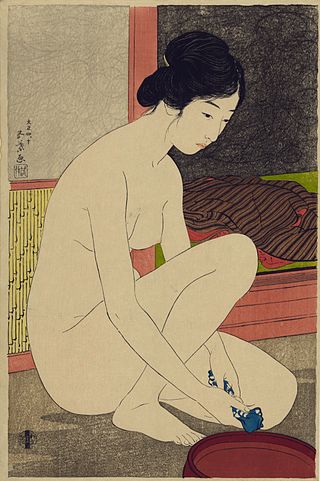
Shin-hanga was an art movement in early 20th-century Japan, during the Taishō and Shōwa periods, that revitalized the traditional ukiyo-e art rooted in the Edo and Meiji periods. It maintained the traditional ukiyo-e collaborative system where the artist, carver, printer, and publisher engaged in division of labor, as opposed to the parallel sōsaku-hanga movement.

Sōsaku-hanga was an art movement of woodblock printing which was conceived in early 20th-century Japan. It stressed the artist as the sole creator motivated by a desire for self-expression, and advocated principles of art that is "self-drawn", "self-carved" and "self-printed". As opposed to the parallel shin-hanga movement that maintained the traditional ukiyo-e collaborative system where the artist, carver, printer, and publisher engaged in division of labor.

Japanese painting is one of the oldest and most highly refined of the Japanese visual arts, encompassing a wide variety of genres and styles. As with the history of Japanese arts in general, the long history of Japanese painting exhibits synthesis and competition between native Japanese aesthetics and the adaptation of imported ideas, mainly from Chinese painting, which was especially influential at a number of points; significant Western influence only comes from the 19th century onwards, beginning at the same time as Japanese art was influencing that of the West.

Uemura Shōen was the pseudonym of an artist in Meiji, Taishō and early Shōwa period Japanese painting. Her real name was Uemura Tsune. Shōen was known primarily for her bijin-ga, or paintings of beautiful women, in the nihonga style, although she produced numerous works on historical themes and traditional subjects. Shōen is considered a major innovator in the bijin-ga genre despite the fact she often still used it to depict the traditional beauty standards of women. Bijin-ga gained criticism during the Taisho era while Shōen worked due to its lack of evolution to reflect the more modern statuses of women in Japan. During bijin-ga's conception in the Tokugawa, or Edo, period, women were regarded as lower class citizens and the genre often reflected this implication onto its female subjects. Within the Taisho era, women had made several advancements into the Japanese workforce, and artistry specifically was becoming more popular outside of pass times for the elite, which opened way for Shōen's success. Shōen received many awards and forms of recognition during her lifetime within Japan, being the first female recipient of the Order of Culture award, as well as being hired as the Imperial Household's official artist, which had previously only employed one other official woman in the position. In 1949 she died of cancer just a year after receiving the Order of Culture Award.

Utagawa Yoshiiku, also known as or Ochiai Yoshiiku, was a Japanese artist of the Utagawa school.

Shōzaburō Watanabe was a Japanese print publisher and the driving force behind one of the woodblock printmaking movements known as shin-hanga.
Shunsen Natori was a Japanese woodblock printer, considered by many to be the last master in the art of kabuki yakusha-e "actor pictures".
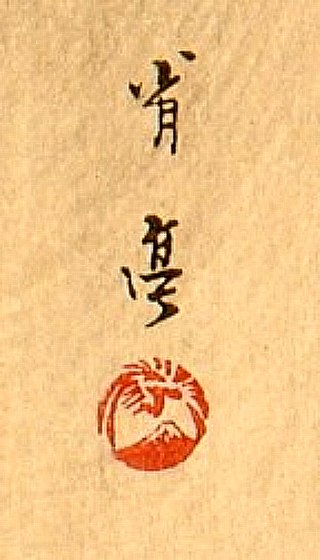
Watanabe Seitei, also known as Watanabe Shōtei, was a Japanese Nihonga painter who was one of the first Japanese painters to visit Europe, attending the 1878 International Exhibition in Paris and being awarded a medal. He blended Western realism with the delicate colours and washes of the Kikuchi Yōsai school, introducing a new approach to kachōga.

Takahashi Shōtei (高橋松亭), born Hiroaki was a 20th-century Japanese woodblock artist in the shinsaku-hanga and later shin-hanga art movements.
Torii Kotondo or Torii Kiyotada V was a Japanese painter and woodblock printer of the Torii school of ukiyo-e artists. He followed his school's tradition of making prints of kabuki actors (yakusha-e) and involvement with commercial work for kabuki theater. His twenty-one bijin-ga are particularly celebrated.

Chen Chin, also written as Ch'en Chin, was a Taiwanese painter, known for her paintings of women (bijin). She is said to be the first Taiwanese woman painter to earn national recognition.
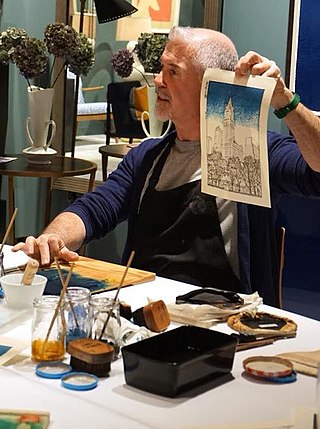
Paul Binnie is a Scottish artist working in the Japanese tradition of woodblock printing. His work is reflective of the shin-hanga artists of the early to mid-20th century, employing subjects such as landscapes, tattoos, and bijin.

Hirafuku Hyakusui, originally named Teizō was a Japanese painter in the nihonga style.

Shiro Kasamatsu was a Japanese engraver and print maker trained in the Shin-Hanga and Sōsaku-Hanga styles of woodblock printing.

Tsuchiya Kōitsu was a Japanese artist in the Shin-hanga movement. He trained under the ukiyo-e master Kobayashi Kiyochika for 19 years, and initially focused on works depicting scenes from the First Sino-Japanese War. In 1931, at the age of 60, he began work for Shōzaburō Watanabe and his art publishing establishment which also published the work of artists like Kawase Hasui and Yoshida Hiroshi. His later work incorporated light effects to increase the emotional impact of his art.


















